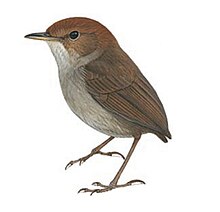Tesia
| Tesia | |
|---|---|

| |
| Russet-capped tesia (Tesia everetti) | |
| Scientific classification | |
| Domain: | Eukaryota |
| Kingdom: | Animalia |
| Phylum: | Chordata |
| Class: | Aves |
| Order: | Passeriformes |
| Family: | Cettiidae |
| Genus: | Tesia Hodgson, 1837 |
| Type species | |
| Tesia cyaniventer[1] Hodgson, 1837
| |

| |
The tesias are a genus, Tesia, of
Taxonomy
The genus Tesia was erected in 1837 by the English naturalist
Range and diversity
The genus has a disjunct distribution in South and South East Asia. The three northern species range widely across southern China, Burma, Northern Thailand and Laos and into India, southern Nepal and Vietnam; whereas the other two species are found in
Description
Tesias are tiny ground-living warblers which range in length from 7–10 cm and weigh between 6-12 g.[9] They have long legs and an upright stance, and appear to almost lack a tail, as their tail rectrices are shorter than the tail coverts.[10] The plumage of the northern species is olive backs and wings and grey bellies (darker slate in the slaty-bellied tesia); the southern species have brown wings and backs. All species have an eye-stripe and all except the slaty-bellied tesia have a supercilium; this is most prominent in the Javan tesia. The plumage of the chestnut-headed tesia is different from the other species; it has a bright yellow belly, chest and throat, and a deep chestnut coloured head and an incomplete white orbital ring. It lacks the facial stripes of the other species. The bill of all species is long and bicoloured,[10] with a dark upper mandible and a flesh-coloured lower one, as well as strong ridge on the upper mandible.
Habits

Tesias live in the undergrowth of forest, usually montane broadleaf forest.[9] They have a preference for damp forest, and are often found near water, particularly the Chestnut-headed and slaty-bellied tesias, although they use a range of microhabitats within the forest, including patches of bamboo or nettles. The three northern species are altitudinal migrants, breeding up to 4,000 m but wintering as low as 150 m. The two southern species are resident within their range.
The tesias are active insectivores that usually feed near the ground amongst the undergrowth and leaf litter, but may forage as high as 25 m off the ground (in the case of the
Breeding
There is little information about the breeding biology of the tesias, only three species, the Grey-bellied, Chestnut-headed and Javan, have even had their nests described.[9] They are seasonal breeders, with the Grey-bellied and russet-capped tesias nesting in May–July, and the Javan tesia having two seasons, April–June and October to December. The nest is a ball of moss for the grey-bellied tesia and plant fibres, moss and roots, and is fixed into vegetation or moss on the side of a tree, low down. The clutch size of the grey-bellied tesia is 3-5 eggs, but only 2 eggs for the Javan tesia and chestnut-headed tesia. In the chestnut-headed tesia both sexes incubate the clutch; this species is also known to occasionally be parasitized by the lesser cuckoo.
Status
None of the tesias are considered to be
Species
The four species are:[12]
| Image | Common Name | Scientific name | Distribution |
|---|---|---|---|
| Slaty-bellied tesia | Tesia olivea | Bhutan to north Vietnam | |
 |
Grey-bellied tesia | Tesia cyaniventer | north India to south Vietnam |
| Javan tesia | Tesia superciliaris | west Java, Indonesia | |
| Russet-capped tesia | Tesia everetti | Sumbawa & Flores islands, east Indonesia |
References
- ^ "Scotocercidae". aviansystematics.org. The Trust for Avian Systematics. Retrieved 2023-07-15.
- PMID 16054402
- ^ ISBN 9781408134016.
- ^ Hodgson, Brian Houghton (1837). "On three new genera or sub-genera of long-legged thrushes, with descriptions of their species". Journal of the Asiatic Society of Bengal. 6 (1): 101–104 [101].
- ISBN 978-1-4081-2501-4.
- ^ Gray, George Robert (1840). A List of the Genera of Birds : with an Indication of the Typical Species of Each Genus. London: R. and J.E. Taylor. p. 27.
- ^ Mayr, Ernst; Cottrell, G. William, eds. (1986). Check-List of Birds of the World. Vol. 11. Cambridge, Massachusetts: Museum of Comparative Zoology. p. 5.
- PMID 22142197.
- ^ ISBN 84-96553-06-X.
- ^
- ^ IUCN (2007). IUCN Red List of Threatened Species: Tesia. <www.iucnredlist.org>. Downloaded on 27 April 2008.
- Rasmussen, Pamela, eds. (2020). "Cupwings, crombecs, bush warblers, Streaked Scrub Warbler, yellow flycatchers, hylias". IOC World Bird List Version 10.1. International Ornithologists' Union. Retrieved 12 June 2020.
